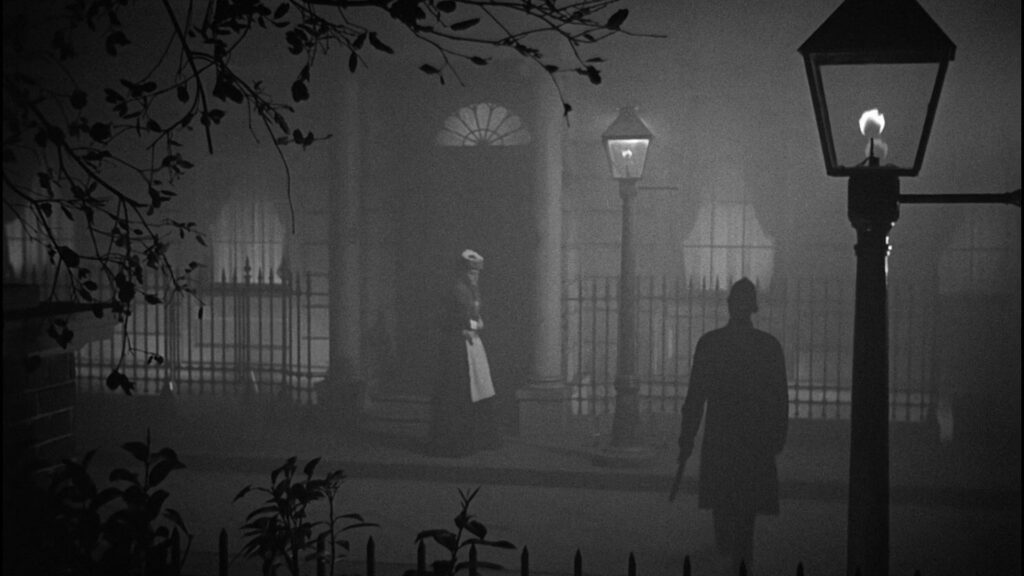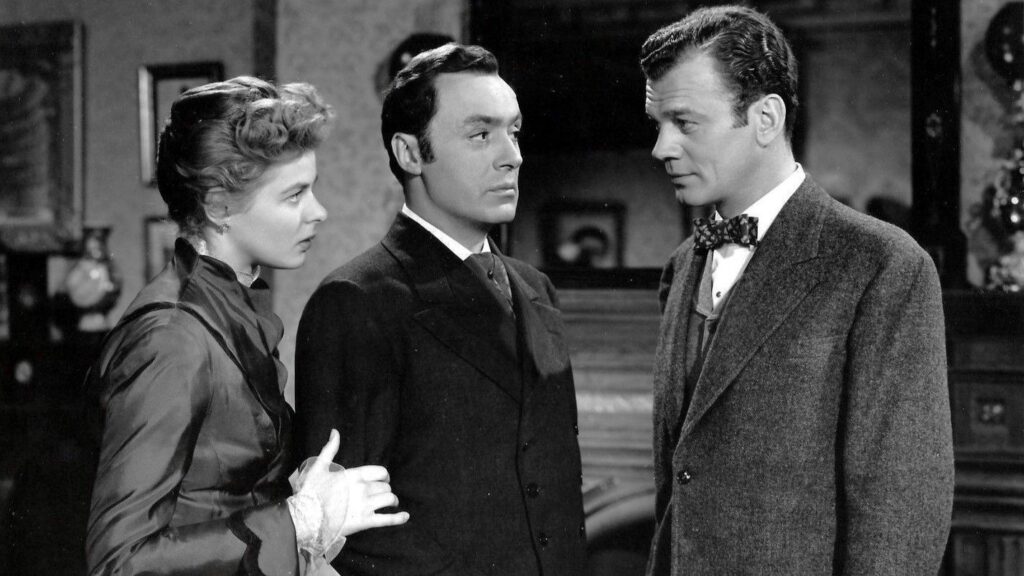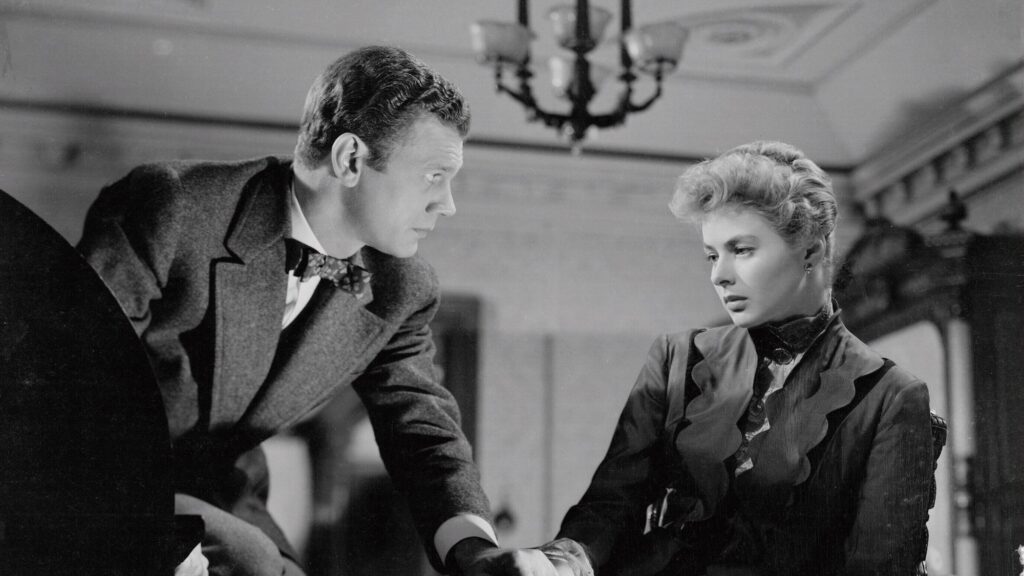Does that make me crazy?
Remember when Merriam-Webster crowned “gaslighting” the word of the year in 2022? Not, alas, because the world collectively rediscovered a black-and-white studio thriller from 1944. But George Cukor’s Gaslight popularized the term decades earlier: a case study in psychological erosion and falsely suggested insanity. The story takes place in 1880s London and is buoyed a masterclass of Gothic mood that accents the growing self-doubt of its protagonist: creaking doors, foggy streets, astonishing shadows, and those titular flames that dim and flare like a conscience in a murky world.
The film comes from Patrick Hamilton’s stage success Angel Street and is a remake of a less-seen but widely praised 1940 British film also called Gaslight, one MGM tried to bury as soon as it secured the rights for this do-over. The attempts by MGM to completely eradicate prints of the original failed, and you can still find the 1940 film today (though I have not seen it).

Gaslight (1944 edition) takes the perspective of newly married Paula (Ingrid Bergman). She returns to her late aunt’s London townhouse with her suave, ambiguously accented husband Gregory (Charles Boyer). Paula’s celebrity aunt, whose murder was never solved, hangs around like a ghost; her memory and possessions make every room a graveyard. Soon Paula’s reality flickers: brooches disappear, picture frames move, and ghostly footsteps thunk from above. But the question lingers: How much of it is Paula’s sanity slipping, and how much of it is her husband manipulating her? We as viewers have no reason to suspect the film is applying subjective or filtered reality, plus we all know what “gaslighting” means, so it becomes excruciating to watch Paula succumb to Gregory’s manipulations across the runtime.
Every night, Gregory leaves for work, the servants trade looks, the lights dim, and Paula’s grip on her reality loosens. An impertinent maid, Nancy (Angela Lansbury), not-so-subtly coveting the charming Gregory and resenting Paula’s cushy life, fans the unease. Nosy neighbor Miss Thwaites (Dame May Whitty) tries desperately to figure out what’s going on, though she’s more comic relief than dramatic chess piece. Most crucially, Scotland Yard man Brian Cameron (Joseph Cotten) starts connecting Paula’s situation to the cold case murder, culminating in a late-night raid and a reckoning in the barred-off upper floor where the ghostly thuds echo every night.
Gaslight doesn’t exactly have twists: It lays out its premise in the opening half hour, then methodically follows that path, interrupted only by Cotten’s interloper. What keeps this straight-line narrative riveting is the slow-turn screw of Cukor’s staging, and how that puts you in Paula’s psychology. He and his team calibrate the film’s space to perfection: doorways swallow people into shadows, stairways yawn into frigid darkness, hallways collapse the frame inward. The film’s most potent special effect is its title cue: the house lights flickering in sync with Paula’s panic. Every craft choice is in line with the story, pushing us deeper into Paula’s interiority: the camera creeping closer as the world shrinks, the sound design amplifying small frictions until they clang. It’s absolutely stunning Gothic filmmaking.

The cast is a proper specimen of classic Hollywood talent. Boyer is a menace of affected, duplicitous gestures; truly slimy and infuriating, but also just suave enough you empathize with Paula’s affection for him. Cotten underplays the white-knight role with decency; he reads clues but never grandstands. Lansbury, in a terrific debut, weaponizes her round, expressive eyes, giving some much-needed acid to the role. Whitty makes a very funny nosy neighbor.
Still, the film belongs completely to Bergman. She builds Paula from the inside out, letting fragments of brightness survive the daily abrasion. Watch how she modulates between self-confidence and self-doubt, the former slowly eroding away: the small stammers, the fixed smiles, the way her voice grows papery when she asks for reassurance she knows won’t arrive. It’s a psychologically rich performance from one of the greats, not a gallery of “big” Oscar reel breakdowns but a sequence of micro-fractures that accumulate into a portrait of entrapment. When Paula finally faces Gregory in the attic, Bergman plays not triumph but a complicated blend of fury, grief, and self-recognition, her interior development more important than what’s happening in the plot.

Here’s where I remain torn: Gaslight’s march toward its conclusion can feel lugubrious — a boulder rolling downhill in slow motion. That unhurried inevitability is thematically apt (Paula must be dismantled grain by grain for the manipulation to really work), but I still found myself hungry for bigger swings along the way. Even more frustrating is the film’s refusal to grant Paula full agency in the resolution. Gregory’s undoing hinges on Cotten’s detective work. Paula’s confrontation with Gregory is boxed in by the Hays Code and the script’s paternalism. The moment where she brandishes a blade in his face promises a messier, more cathartic reckoning than the movie allows. That’s not me importing modern feminism so much as asking for payoff proportional to the pressure Cukor so expertly cranks upon Paula.
Quibbles aside, Gaslight clarified something for me: I’ve been underrating Cukor. I tend to think first of the actors when I consider Philadelphia Story or A Star Is Born, but here the unity of design, performance, and tempo is unmistakably his achievement. The film is satisfying; a fully realized vision from a great craftsman. Cukor really immerses us in the experience: When the lights dim and Paula glances up at those lights, I forget everything else and feel the floor tilt with her. Word of the year or not, Gaslight is one of cinema’s defining portraits of psychological treachery, a ridiculously beautiful specimen of studio-era Hollywood.
Is It Good?
Very Good (6/8)
Dan is the founder and head critic of The Goods. Follow Dan on Letterboxd. Join the Discord for updates and discussion.


2 replies on “Gaslight (1944)”
“Hayyyss Code…someone still loves youuuu” that’s my Queen redux.
This was a massive hit in my house growing up and the power has never worn off. Got to show it to my wife a few years ago and she loved it. I might have to go tour de good on this one. Unstoppable Ingrid.
It’s definitely a special one — glad to hear it’s a favorite masterpiece of yours. Ingrid is really something.
I’m not sure I’ve ever met someone else who has adopted “pro-Hays code” as one of their corners.